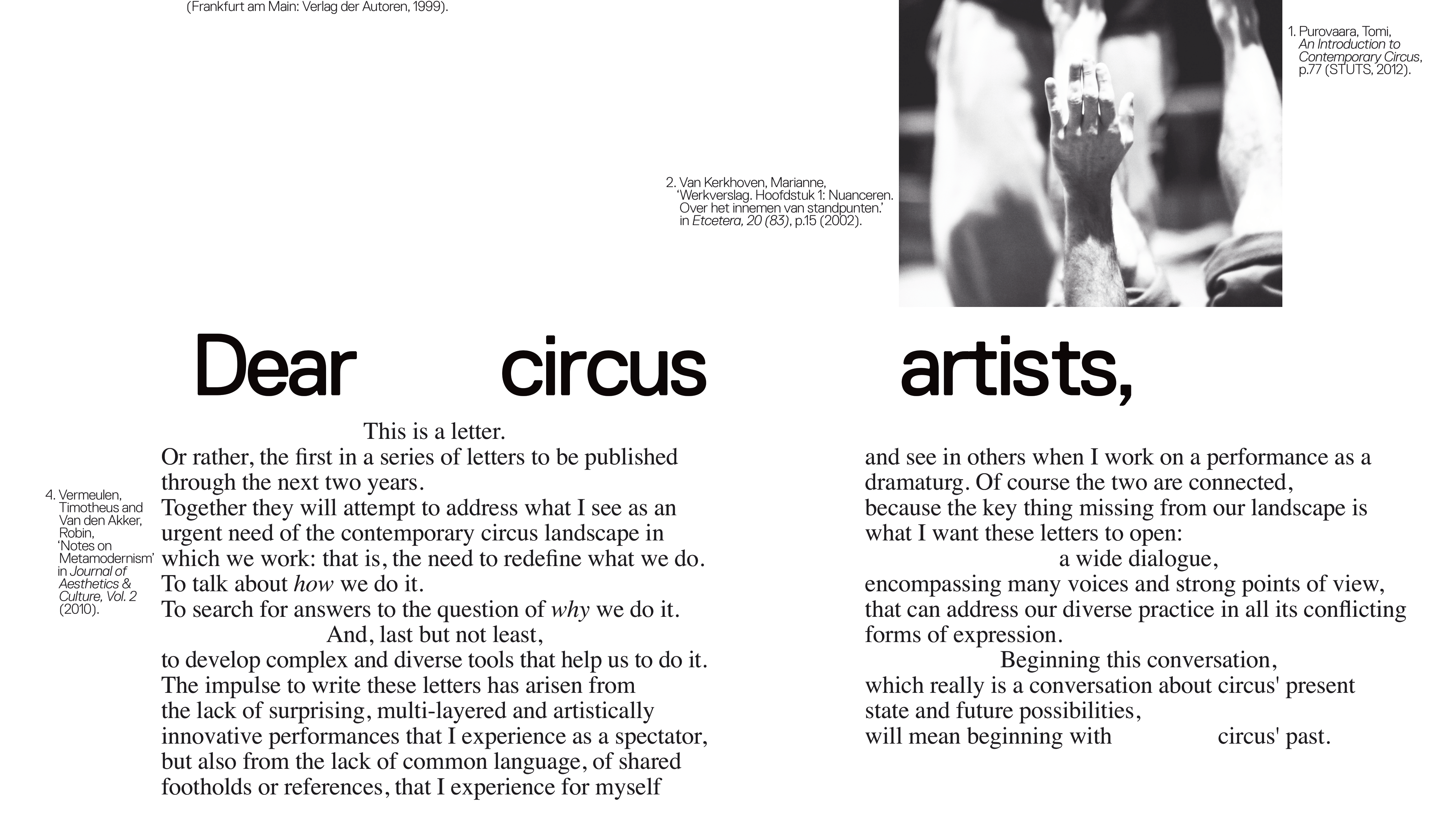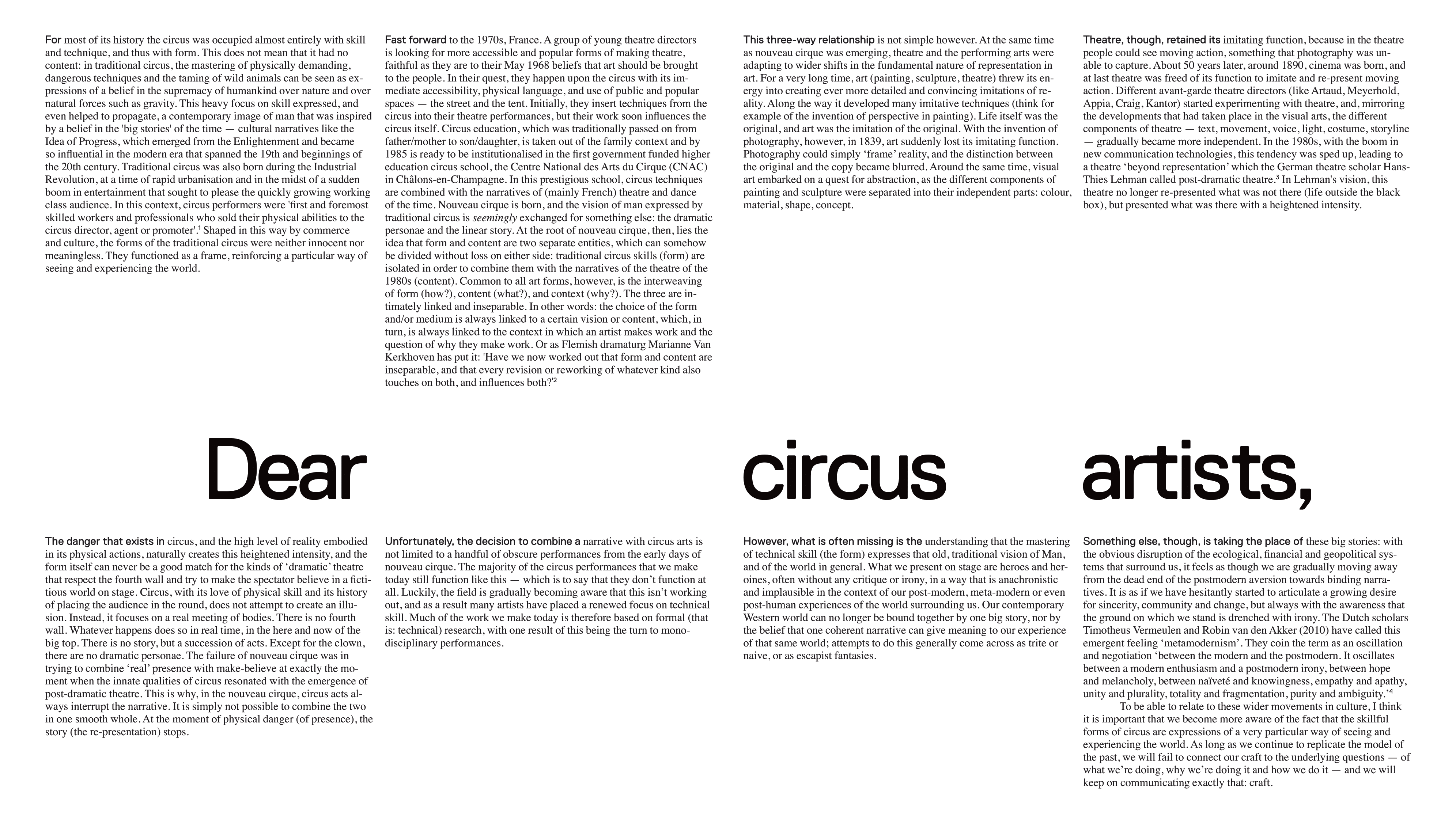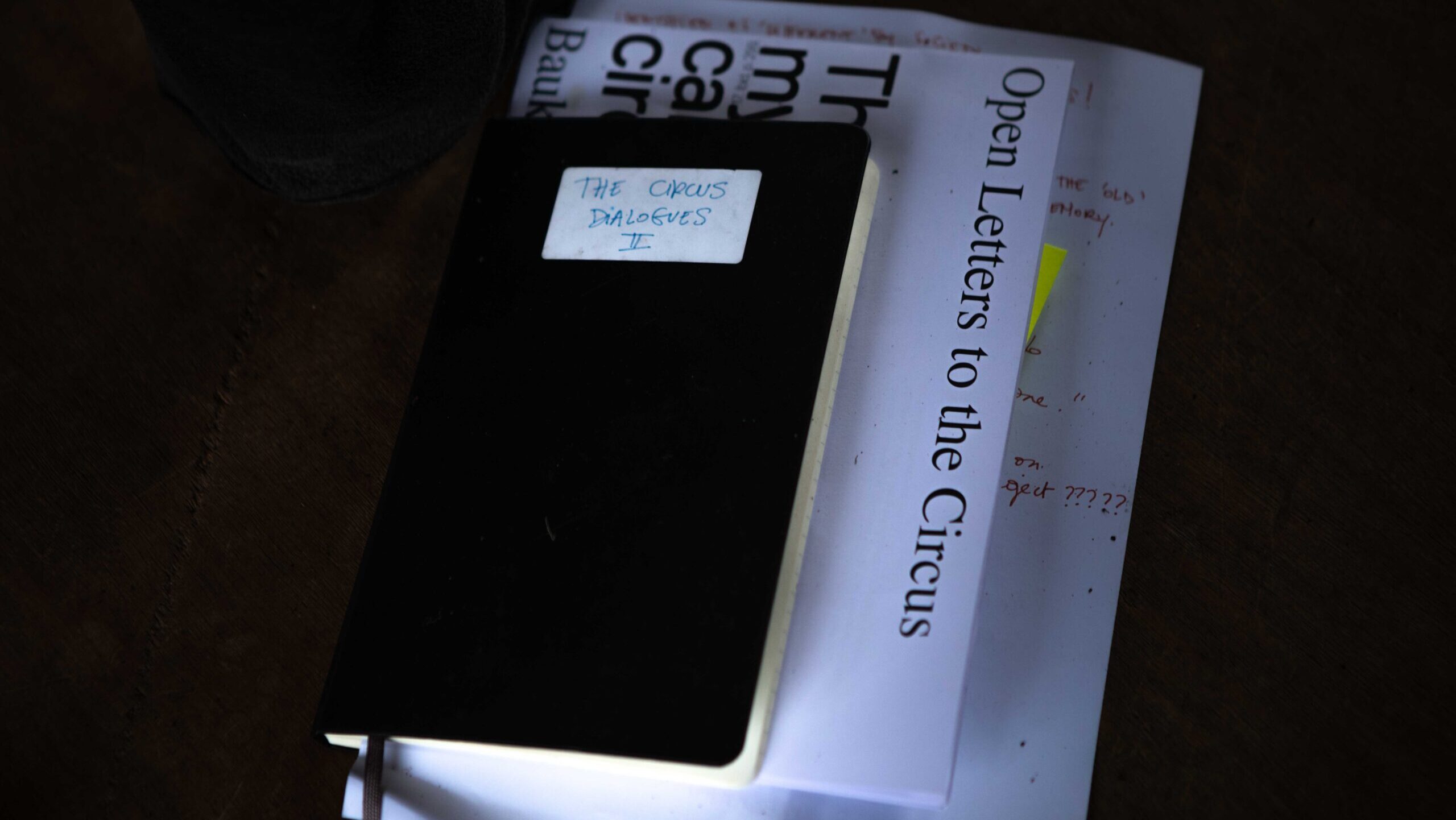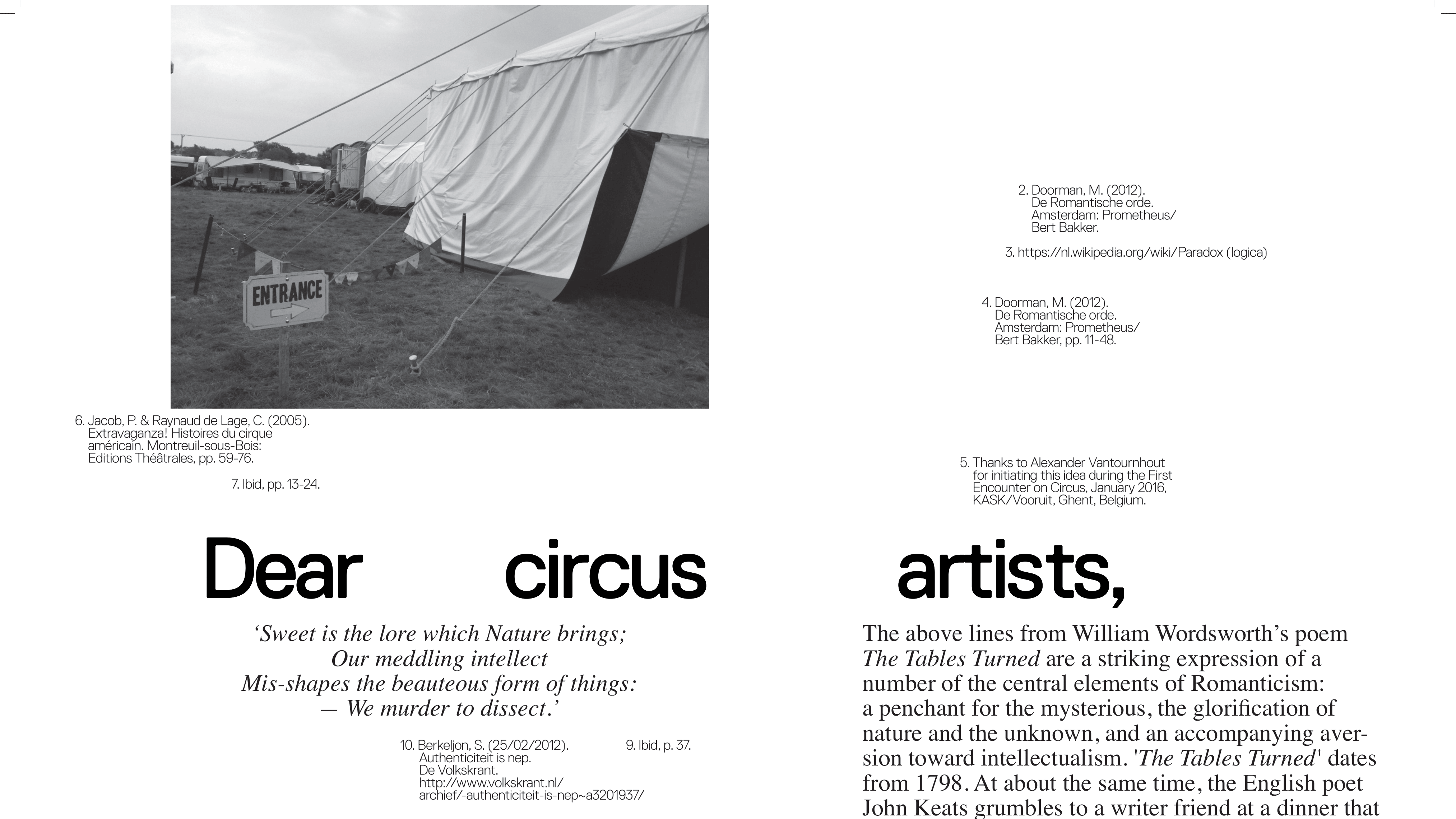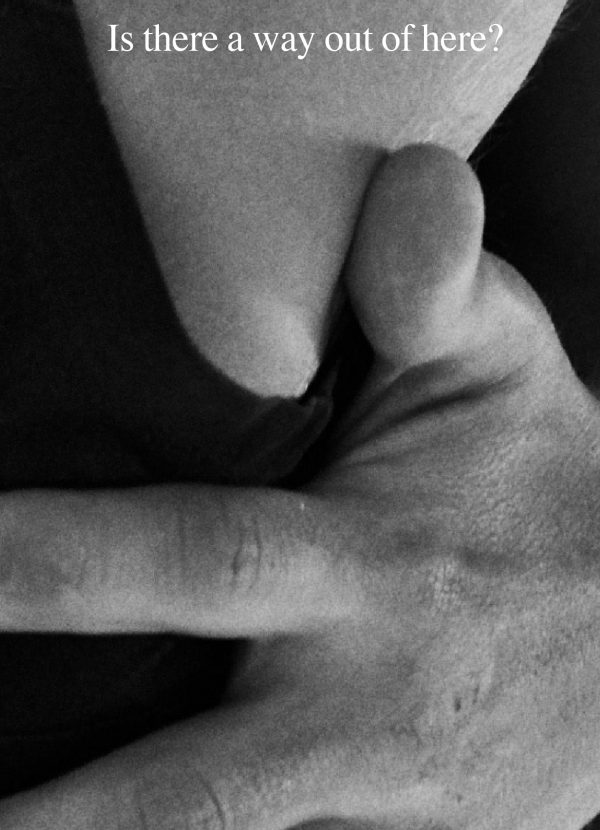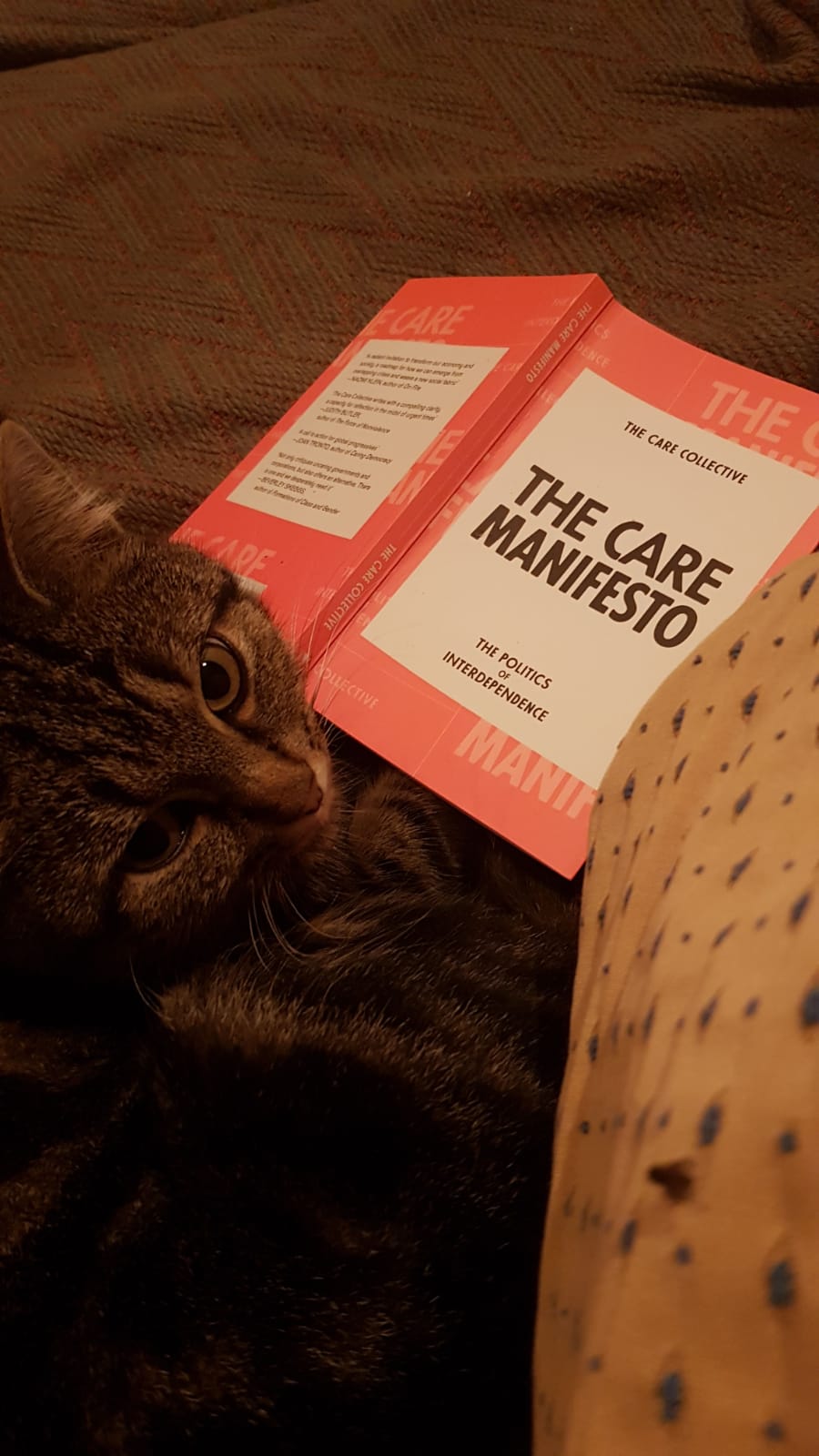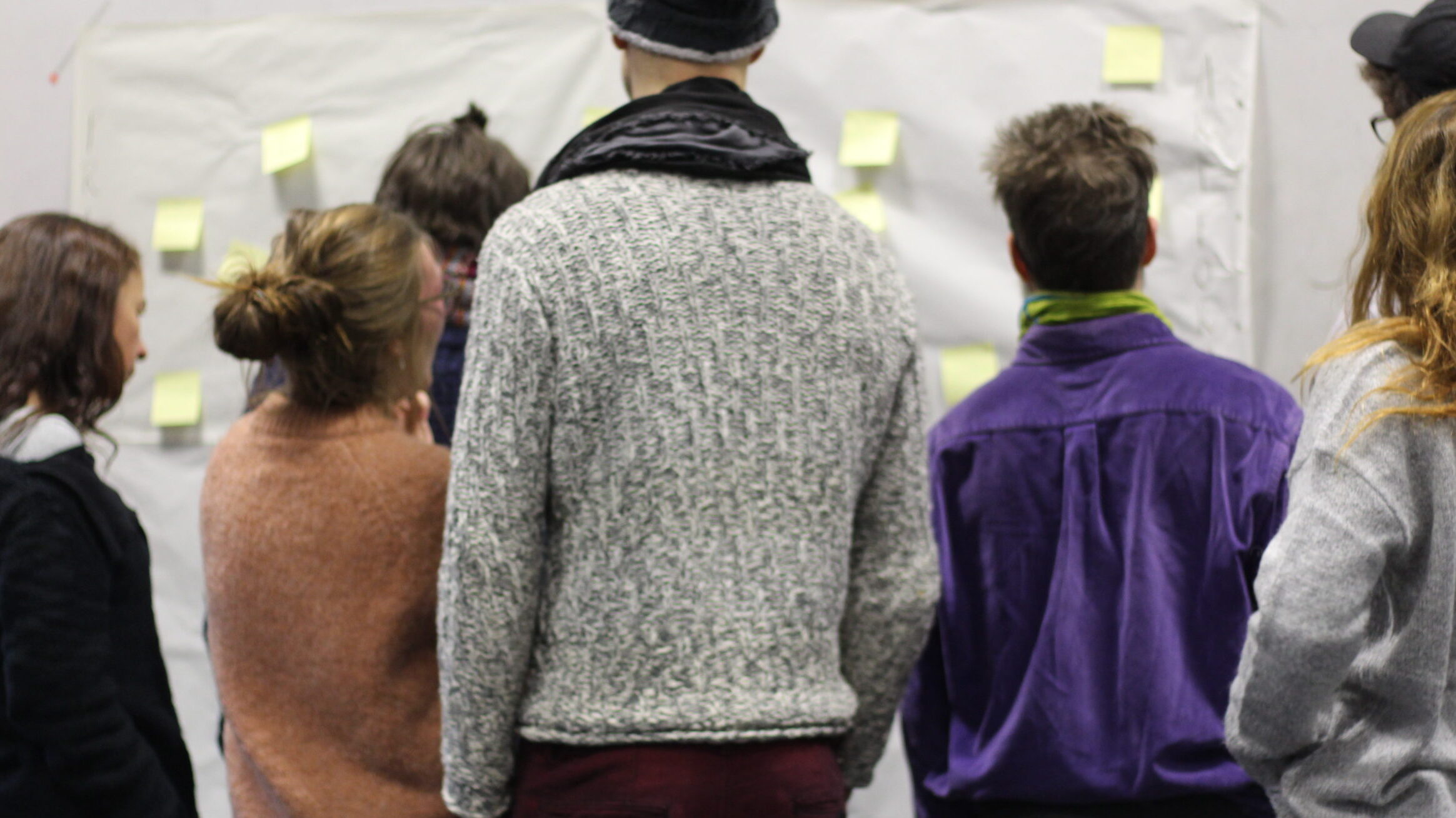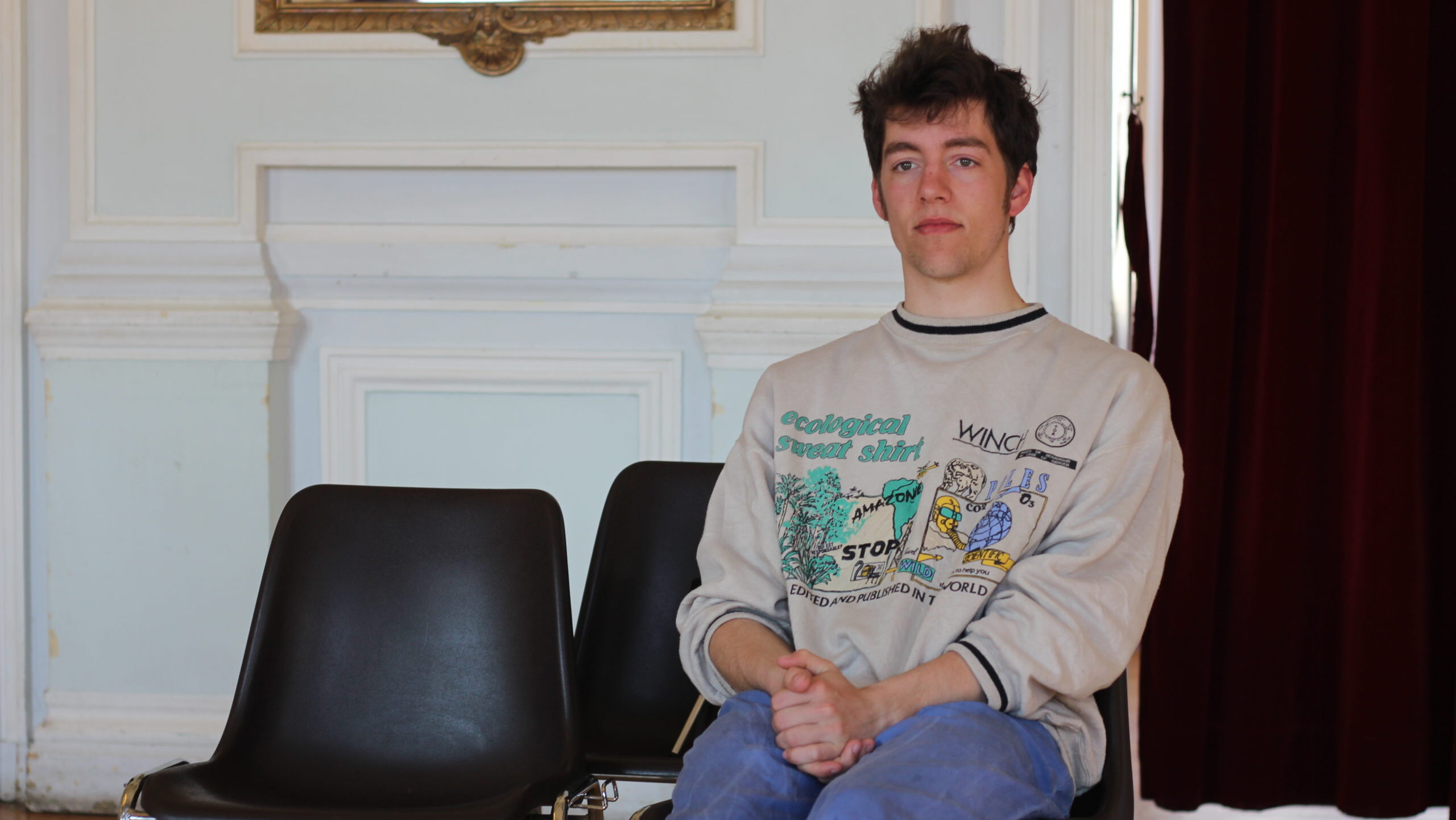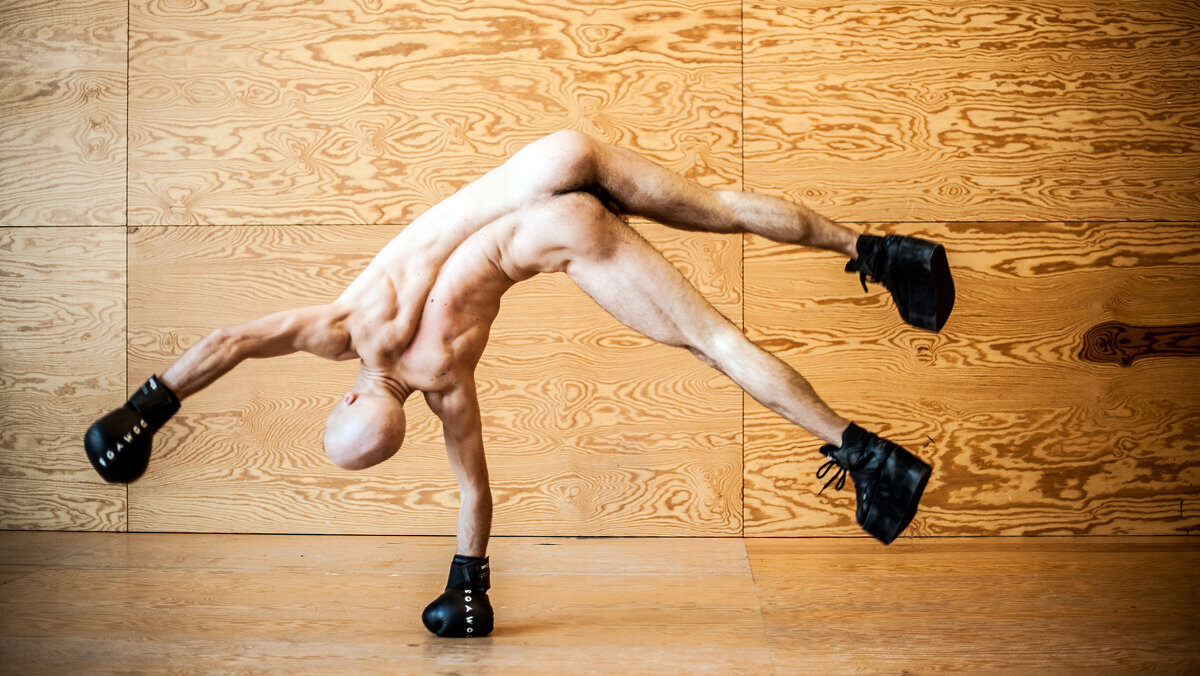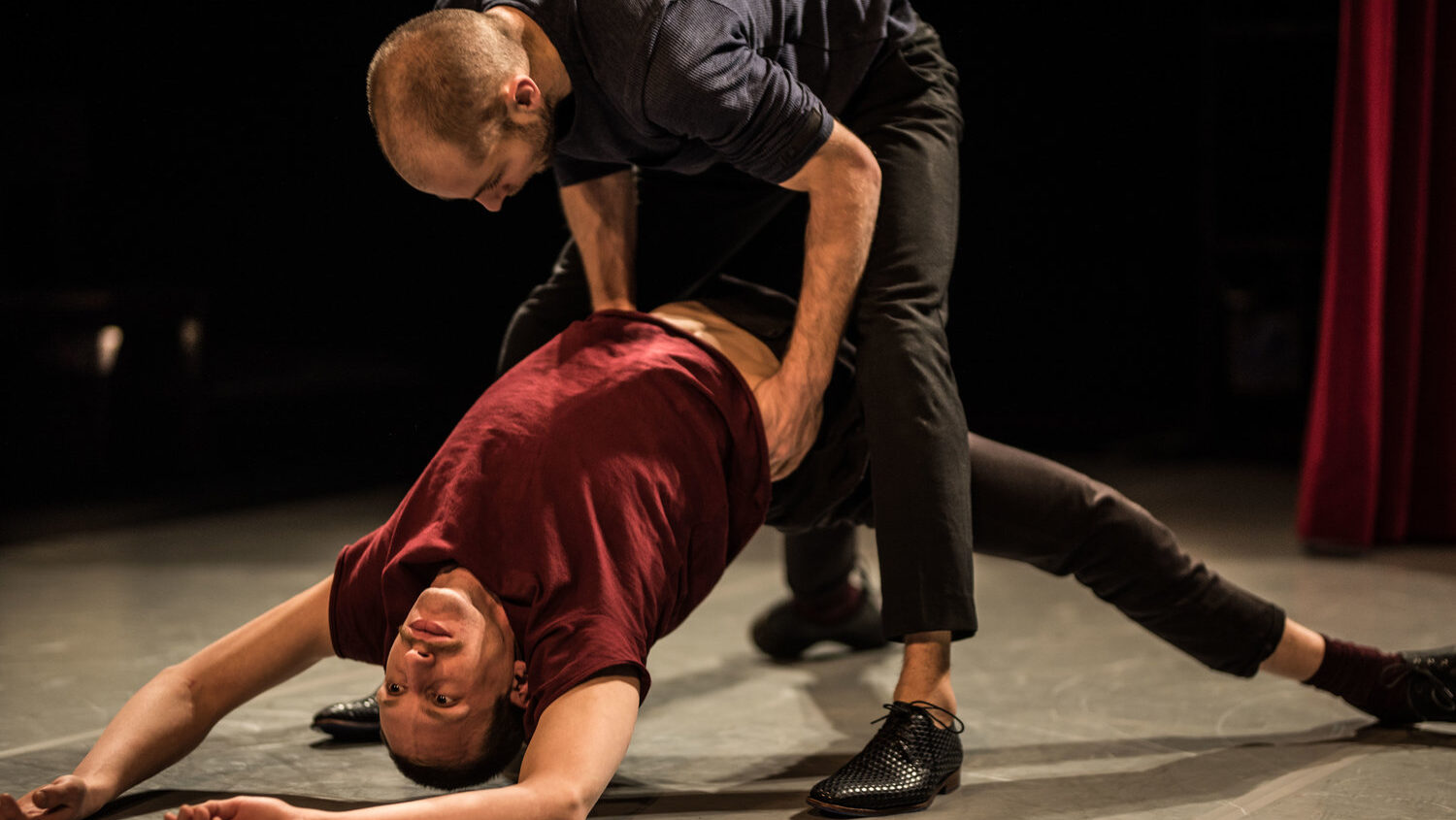The need to redefine
Le Besoin de Redéfinir
De Nood aan een Herdefiniëring
Dear circus artists,
This is a letter. Or rather, the first in a series of letters to be published through the next two years. Together they will attempt to address what I see as an urgent need of the contemporary circus landscape in which we work: that is, the need to redefine what we do. To talk about how we do it. To search for answers to the question of why we do it. And, last but not least, to develop complex and diverse tools that help us to do it.
The impulse to write these letters has arisen from the lack of surprising, multi-layered and artistically innovative performances that I experience as a spectator, but also from the lack of common language, of shared footholds or references, that I experience for myself and see in others when I work on a performance as a dramaturg.
The two are connected, because the key thing missing from our landscape is what I want these letters to open: a wide dialogue, encompassing many voices and strong points of view, that can address our diverse practice in all its conflicting forms of expression. Beginning this conversation, which really is a conversation about circus’ present state and future possibilities, will mean beginning with circus’ past.
For most of its history the circus was occupied almost entirely with skill and technique, and thus with form. This does not mean that it had no content: in traditional circus, the mastering of physically demanding, dangerous techniques and the taming of wild animals can be seen as expressions of a belief in the supremacy of humankind over nature and over natural forces such as gravity. This heavy focus on skill expressed, and even helped to propagate, a contemporary image of man that was inspired by a belief in the ‘big stories’ of the time — cultural narratives like the Idea of Progress, which emerged from the Enlightenment and became influential in the modern era that spanned the 19th and beginnings of the 20th century. Traditional circus was also born during the Industrial Revolution, at a time of rapid urbanisation and in the midst of a sudden boom in entertainment that sought to please the quickly growing working class audience. In this context, circus performers were ‘first and foremost skilled workers and professionals who sold their physical abilities to the circus director, agent or promoter’.1 Shaped in this way by commerce and culture, the forms of the traditional circus were neither innocent nor meaningless. They functioned as a frame, reinforcing a particular way of seeing and experiencing the world.
Fast forward to the 1970s, France. A group of young theatre directors is looking for more accessible and popular forms of making theatre, faithful as they are to their May 1968 beliefs that art should be brought to the people. In their quest, they happen upon the circus with its immediate accessibility, physical language, and use of public and popular spaces — the street and the tent. Initially, they insert techniques from the circus into their theatre performances, but their work soon influences the circus itself. Circus education, which was traditionally passed on from father/mother to son/daughter, is taken out of the family context and by 1985 is ready to be institutionalised in the first government funded higher education circus school, the Centre National des Arts du Cirque (CNAC) in Châlons-en-Champagne. In this prestigious school, circus techniques are combined with the narratives of (mainly) French theatre and dance of the time. Nouveau cirque is born, and the vision of man expressed by traditional circus is seemingly exchanged for something else: the dramatic personae and the linear story. At the root of nouveau cirque, then, lies the idea that form and content are two separate entities, which can somehow be divided without loss on either side: traditional circus skills (form) are isolated in order to combine them with the narratives of the theatre of the 1980s (content). Common to all art forms, however, is the interweaving of form (how?), content (what?), and context (why?). The three are intimately linked and inseparable. In other words: the choice of the form and/or medium always expresses a certain vision or content, which, in turn, is always linked to the context in which an artist makes work and the question of why they make work. Or as Flemish dramaturg Marianne Van Kerkhoven has put it: ‘Have we now worked out that form and content are inseparable, and that every revision or reworking of whatever kind also touches on both, and influences both?’2
This three-way relationship of form, content and context is not simple, however, and at the same time as nouveau cirque was emerging, theatre and the performing arts were adapting to wider shifts in the fundamental nature of representation in art. For a very long time, art (painting, sculpture, theatre) threw its energy into creating ever more detailed and convincing imitations of reality. Along the way it developed many imitative techniques (think for example of the invention of perspective in painting). Life itself was the original, and art was the imitation of the original. With the invention of photography, however, in 1839, art suddenly lost its imitating function. Photography could simply ‘frame’ reality, and the distinction between the original and the copy became blurred. Around the same time, visual art embarked on a quest for abstraction, as the different components of painting and sculpture were separated into their independent parts: colour, material, shape, concept.
Theatre, though, retained its imitating function, because in the theatre people could see moving action, something that photography was unable to capture. About 50 years later, around 1890, cinema was born, and at last theatre was freed of its function to imitate and re-present moving action. Different avant-garde theatre directors (like Artaud, Meyerhold, Appia, Craig, Kantor) started experimenting with theatre, and, mirroring the developments that had taken place in the visual arts, the different components of theatre — text, movement, voice, light, costume, storyline — gradually became more independent. In the 1980s, with the boom in new communication technologies, this tendency was sped up, leading to a theatre beyond representation which the German theatre scholar Hans-Thies Lehman called post-dramatic theatre.3 In Lehman’s vision, this theatre no longer re-presented what was not there (life outside the black box), but presented what was there with a heightened intensity.
The danger that exists in circus, and the high level of reality embodied in its physical actions, naturally creates this heightened intensity, and the form itself can never be a good match for the kinds of old-fashioned, ‘dramatic’ theatre that respect the fourth wall and try to make the spectator believe in a fictitious world on stage. Circus, with its love of physical skill and its history of placing the audience in the round, does not attempt to create an illusion. Instead, it focuses on a real meeting of bodies. There is no fourth wall. Whatever happens does so in real time, in the here and now of the big top. There is no story, but a succession of acts. Except for the clown, there are no dramatic personae. The failure of nouveau cirque was in trying to combine real presence with make-believe at exactly the moment when the innate qualities of circus resonated with the emergence of post-dramatic theatre. This is why, in the nouveau cirque, circus acts always interrupt the narrative. It is simply not possible to combine the two in one smooth whole. At the moment of physical danger (of presence), the story (the re-presentation) simply stops.
Unfortunately, the decision to combine a narrative with circus arts is not limited to a handful of obscure performances from the early days of nouveau cirque. The majority of the circus performances that we make today still function like this — which is to say that they don’t function at all. Luckily, the field is gradually becoming aware that this isn’t working out, and as a result many artists have placed a renewed focus on technical skill. Much of the work we make today is therefore based on formal (that is: technical) research, with one result of this being the turn to mono-disciplinary performances.
However, what is often missing is the understanding that the mastering of technical skill (the form) expresses that old, traditional vision of Man, and of the world in general. What we present on stage are heroes and heroines, often without any critique or irony, in a way that is anachronistic and implausible in the context of our post-modern, meta-modern or even post-human experiences of the world surrounding us. Our contemporary Western world can no longer be bound together by one big story, nor by the belief that one coherent narrative can give meaning to our experience of that same world; attempts to do this generally come across as trite or naive, or as escapist fantasies.
Something else, though, is taking the place of these big stories: with the obvious disruption of the ecological, financial and geopolitical systems that surround us, it feels as though we are gradually moving away from the dead end of the postmodern aversion towards binding narratives. It is as if we have hesitantly started to articulate a growing desire for sincerity, community and change, but always with the awareness that the ground on which we stand is drenched with irony. The Dutch scholars Timotheus Vermeulen and Robin van den Akker (2010) have called this emergent feeling ‘metamodernism’. They coin the term as an oscillation and negotiation ‘between the modern and the postmodern. It oscillates between a modern enthusiasm and a postmodern irony, between hope and melancholy, between naivete and knowingness, empathy and apathy, unity and plurality, totality and fragmentation, purity and ambiguity.’4
To be able to relate to these wider movements in culture, I think it is important that we become more aware of the fact that the skillful forms of circus are expressions of a very particular way of seeing and experiencing the world. As long as we continue to replicate the model of the past, we will fail to connect our craft to the underlying questions — of what we’re doing, why we’re doing it and how we do it — and we will keep on communicating exactly that: craft.
It is true that we cannot start to create and express a different content to that of the traditional circus if we do not master the technical skills that are the language of the art. But we will not create artistically renewing work only through the repetition of technical skill and existing ‘repertoire’, and skill itself does not have to be placed at the core of our practice; rather, we can attempt to define our medium in other terms.
There are many possible approaches, but here I’d like to suggest an understanding of circus as a form in which the virtuoso body is central. However, I would also like to redefine virtuosity. What the circus body does on stage / in the ring is not meaningless; its actions are always part of an attempt to overcome some physical limit. The circus body constantly pushes the limits of the possible, and incessantly displaces the goals of its physical actions, such that it never attains these goals and limits: they are always moving to be just out of reach. What is expressed through the forms of circus is not the old vision of mastery, then, but an understanding of human action that is fundamentally tragic. Virtuosity is nothing more than the vainly striving human being ‘at work’. What appears in the ring is a battle with an invisible adversary (the different forces of nature), in which the goal is not to win but to resist and not to lose. Circus is both the promise of tragedy and the attempt to escape from tragedy. This makes the circus performer into a tragic hero.
We can also consider the relationship of the virtuoso body to objects that are external to it, be they props or pieces of apparatus (a trapeze, a cloudswing, a juggling ball) or the bodies of other artists. In a 2009 essay the Italian philosopher Giorgio Agamben proposes a distinction of beings into two large groups: ‘on the one hand, living beings (or substances), and on the other, apparatuses in which living beings are incessantly captured’.5 His understanding of an apparatus, building on the work of Foucault, encompasses ‘literally anything that has in some way the capacity to capture, orient, determine, intercept, model, control, or secure the gestures, behaviours, opinions, or discourses of living beings’, from language itself, to cell phones, cigarettes, the pen and computers. A subject then, to Agamben, is the third category that results from the relationship, or ‘the relentless fight’, between living beings and apparatuses.6
The dance scholar André Lepecki has already applied this Agambian understanding of the division between living beings and apparatuses to contemporary dance and performance, but the circus seems to be a battleground par excellence on which Agamben’s ‘relentless fight’ between human beings and apparatuses can take place.7 The traditional circus stages the human being in a relationship of supremacy and dominance over the objects in the ring (other bodies, animals, circus equipment), but the technique itself also functions as an apparatus that disciplines the body: it is shaped to a specific standard of perfection, and in this way its identity is erased. The traditional circus performer, who is meant to be heroic, then appears as a mere anonymous body — meaningless and without subjectivity.
If the circus is to be capable of staging contemporary subjectivities and identities, it is crucial that we start experimenting with different relationships to our apparatuses, techniques and/or objects. Already the relationship between the body and the object has changed dramatically over the last twenty years. It has gone from physical dominance over the trajectories of the object (traditional circus and nouveau cirque), to the object dominating the trajectories of the body (contemporary circus). This is a very important shift, and one that perhaps reflects or engages with our contemporary experience of the world. Like the understanding of human action as fundamentally tragic, it connects circus to the culture and the times in which we live.
It is time for the circus to redefine its raisons d’être and for us to redefine our raisons de faire. If we want circus to become more innovative, surprising, weird and disturbing, we need to understand the intimate bond between the forms of the circus and the content that we can express within those forms. We need to find out what specifics define circus as circus, and this beyond technical skill. Any attempt at defining what we do must be matched by an attempt to mark out the field for artistic research within circus. The two overlap. They are two poles on the same continuum. Without research no ‘new’ definition of the medium can be reached, and without a ‘new’ definition of the medium there can be no possible pathways for artistic research beyond technical skill.
Since circus has historically occupied a somewhat marginal position within the performing arts (as it did in society in general) we need to understand the dynamics of our changing position. Maybe it is time to go beyond circus. Let us search for countless different answers to the questions of why we want to do circus, how we want to do circus, and what we (can possibly) express by doing circus. Let us do that together. Let us discuss and contradict each other.
I’m very much looking forward to hearing your thoughts. Over the course of the following two years, I will be organising several encounters to talk over and discuss together the different topics that these letters try to raise. Meanwhile, your letters, emails and comments are most welcome on bauke.lievens@hogent.be.
Speak soon,
Bauke Lievens
8 December 2015
References
1 Purovaara, Tomi, An Introduction to Contemporary Circus, p.77 (STUTS, 2012)
2 Van Kerkhoven, Marianne, ‘Werkverslag. Hoofdstuk 1: Nuanceren. Over het innemen van standpunten.’ in Etcetera, 20 (83), p.15 (2002)
3 Lehmann, Hans-Thies, The Postdramatic Theatre, translated by Karen Jürs-Munby (London: Routledge, 2006)
4 Vermeulen, Timotheus and Van den Akker, Robin, ‘Notes on Metamodernism’ in Journal of Aesthetics & Culture, Vol. 2 (2010)
5 Agamben, Giorgio, What is an apparatus? (Stanford: Stanford University Press, 2009)
6 Ibid, p. 14
7 Lepecki, André, ‘9 Variations on Things and Performance’ in Thingly Variations in Space, edited by EdElke van Kampenhout (Brussels: MOKUM)
Chèr(e)s artistes de cirque,
ceci est une lettre. Ou plutôt, la première d’une série de lettres qui seront publiées au cours des deux prochaines années. Ensemble, ces lettres tenteront de questionner ce que je perçois comme un besoin urgent du paysage du cirque contemporain dans lequel nous travaillons: c’est à dire, le besoin de redéfinir ce que nous faisons. De parler de comment nous le faisons. De chercher des réponses à la question pourquoi nous le faisons. Et enfin, de développer des outils divers et complexes qui pourront nous aider à le faire.
L’impulsion d’écrire ces lettres provient d’un manque de spectacles artistiquement innovants, surprenants et multiformes – un manque que je ressens en tant que spectatrice. Mais lorsque je travaille sur un spectacle comme dramaturge, je ressens aussi un manque de langage commun, de références et de points d’appuis partagés.
Bien sûr, les deux sont liés, car l’élément clef qui manque dans notre paysage c’est ce que je souhaite que ces lettres puissent ouvrir: un vaste dialogue, englobant de nombreuses voix, de nombreux et forts points de vue qui peuvent questionner notre pratique versatile dans toutes ses formes contradictoires et conflictuelles d’expression. Entamer cette conversation, qui est en réalité une conversation sur l’état actuel du cirque et ses futures possibilités, nous demande de commencer par le passé du cirque.
Pendant longtemps, le cirque a été occupé presque entièrement par la prouesse et la technique, et ainsi par la forme. Cela ne veut pas dire qu’il n’avait pas de contenu: dans le cirque traditionnel, la maîtrise de techniques physiquement exigeantes et dangereuses, ainsi que le dressage d’animaux sauvages peuvent être vus comme des expressions d’une croyance en la suprématie de l’Homme sur la nature et ses forces, telle que la gravité. L’accent sur la prouesse exprimait et aidait même à propager une certaine image contemporaine de l’Homme qui était inspirée par une croyance dans les “grandes histoires” de l’époque – des récits culturels tel que l’Idée du Progrès, qui a émergé des Lumières et a eu tant d’influence sur l’ère moderne qu’il a traversé le 19ème et le 20ème siècle. Le cirque traditionnel est aussi né au seing de la Révolution Industrielle, un temps d’urbanisation rapide et d’une explosion soudaine dans le domaine du divertissement qui cherchait à plaire à un public populaire en rapide croissance. Dans ce contexte, les artistes de cirque étaient ‘avant tout et surtout des travailleurs professionnels qualifiés qui vendaient leurs capacités physiques aux directeurs de cirque, agents ou promoteurs.’1 Les formes du cirque traditionnel, dessinées de cette manière par le commerce et la culture, n’étaient ni innocentes, ni insensées. Elles fonctionnaient comme un cadre, renforçant une manière particulière de voir et d’expérimenter le monde.
Avance rapide jusqu’aux années 1970, en France. Un groupe de jeunes metteurs-en-scène cherche des formes plus accessibles et populaires pour faire du théâtre, fidèles à leurs croyances de mai 1968 que l’art doit être amené au peuple. Dans leur quête, ils tombent sur le cirque avec son accessibilité immédiate, son langage physique et l’utilisation des espaces publics et populaires – la rue et le chapiteau. Au départ, ils insèrent des techniques de cirque dans leurs spectacles de théâtre, mais bientôt leur travail influence le cirque lui-même. L’éducation circassienne, qui se transmettait traditionnellement de père/mère à fils/fille, sort du contexte familial et en 1985 est prêt à s’institutionnaliser dans la première école de cirque d’éducation supérieure financée par le gouvernement, le Centre National des Arts du Cirque (CNAC) à Châlons-en-Champagne. Dans cette école prestigieuse, les techniques de cirque sont combinées avec les récits du théâtre et de la danse (principalement français) de l’époque. Le nouveau cirque est né et la vision de l’Homme exprimée par le cirque traditionnel est apparemment échangée pour quelque chose d’autre: le personnage dramatique et l’histoire linéaire. A la racine du nouveau cirque réside alors l’idée que la forme et le contenu sont deux entités séparées, qui peuvent d’une certaine manière être divisée sans perte d’un côté ou de l’autre: la prouesse du cirque traditionnel (forme) est isolée pour être combinée avec des récits du théâtre des années 1980 (contenu). Commun à toutes les formes d’art, cependant, est l’entrelacement de la forme (le comment), le contenu (le quoi) et le contexte (le pourquoi). Ces trois éléments sont intimement liés et inséparables. En d’autres termes: le choix de la forme et /ou du médium est toujours lié à une certaine vision ou un certain contenu, qui, à leur tour, sont toujours reliés au contexte dans lequel l’artiste travaille et à la question du pourquoi il crée une oeuvre. Ou comme la dramaturge flamande Marianne Van Kerkhoven l’a dit: ‘Sommes-nous à présent arrivés à comprendre que la forme et le contenu sont inséparables et que chaque révision ou édition, de quelque nature que ce soit, touche également les deux et influence les deux?’.2
Pourtant, cette relation triangulaire n’est pas simple. En même temps que le nouveau cirque émergeait, le théâtre et les arts scéniques s’adaptaient à de plus larges changements qui concernaient la question de la représentation dans l’art. Pendant très longtemps, l’art (peinture, sculpture, théâtre) jetait son énergie dans la création des imitations toujours plus détaillées et convaincantes de la réalité. En cours de route, il a développé de nombreuses techniques mimétiques (par exemple, l’invention de la perspective en peinture). La vie elle-même était l’original et l’art était l’imitation de cet original. Avec l’invention de la photographie en 1839, cependant, l’art a subitement perdu sa fonction mimétique. La photographie pouvait simplement ‘cadrer’ la réalité et la distinction entre l’original et la copie devenait floue. A peu près au même moment, l’art visuel s’est embarqué dans une quête d’abstraction, alors que les différents composants de la peinture et de la sculpture devenaient de plus en plus autonomes: couleur, matière, forme, concept.
Le théâtre a maintenu sa fonction mimétique plus longtemps, parce qu’au théâtre les gens pouvaient voir de l’action en mouvement, ce que la photographie ne pouvait saisir. Cinquante ans plus tard, autour de 1890, le cinéma est né et le théâtre fût enfin libéré de sa fonction d’imiter et de re-présenter de l’action en mouvement. Plusieurs metteurs-en scène d’avant-garde (tels qu’Artaud, Meyerhold, Appia, Craig, Kantor) ont commencé à expérimenter avec le théâtre, et en miroir aux développements qui avaient eu lieu dans les arts visuels, les différentes composantes du théâtre – texte, mouvement, voix, lumière, costume, narration – sont graduellement devenues plus indépendantes. Dans les années 1980, avec l’explosion des technologies de communication, cette tendance s’est accélérée, conduisant à un théâtre ‘au-delà de la représentation’, que le critique de théâtre allemand Hans-Thies Lehman, a appelé le théâtre postdramatique.3 Dans la vision de Lehman, ce théâtre ne représente plus ce qui n’est pas là (la vie en dehors de la black box), mais présente ce qui est là avec une intensité augmentée.
Dans le cirque, le danger et le haut-niveau de réalité des actions physiques créent naturellement cette intensité augmentée. La forme elle-même ne peut jamais faire bon ménage avec les genres de théâtre ‘dramatique’ d’un autre temps qui respectent le quatrième mur et qui essayent de faire croire au spectateur à une réalité fictionnelle sur scène. Le cirque, avec son amour pour l’aptitude physique et son historique de mettre le public en rond, ne cherche pas à créer une illusion. Il se concentre plutôt, sur une rencontre réelle de corps. Il n’y a pas de quatrième mur. Quoiqu’il se passe, se passe en temps réel, dans ‘l’ici et maintenant’ du chapiteau. Il n’y a pas d’histoire, mais une succession d’actes. A l’exception du clown, il n’y a pas de personae dramatique. L’échec du nouveau cirque a été de tenter de combiner la présence réelle avec l’illusion théâtrale au moment même où les qualités inhérentes du cirque résonnaient avec l’émergence du théâtre post-dramatique. C’est pour cette raison que, dans le nouveau cirque, le cirque agit toujours comme une interruption de la narration. Il n’est juste pas possible de combiner les deux dans un ensemble harmonieux. Au moment du danger physique (présence), l’histoire (re-présentation) tout simplement, s’arrête.
Seulement, la décision de combiner une narration avec les arts du cirque ne s’est pas limitée à une poignée de spectacles obscurs des premiers jours du nouveau cirque. La majorité des spectacles de cirque que nous faisons aujourd’hui fonctionnent encore ainsi -ce qui revient à dire qu’ils ne fonctionnent pas. Heureusement, il y a aujourd’hui une conscience accrue des façons dont nous créons (et pourrions créer) des spectacles de cirque. En réaction, de nombreux artistes de cirque ont placé une attention renouvelée sur la technique de cirque. Une grande partie du travail que nous faisons aujourd’hui semble ainsi être basée sur une recherche formelle (c’est à dire technique), avec une croissance de la création de spectacles mono-disciplinaires.
Néanmoins, ce qui manque souvent est la compréhension que la maîtrise d’une technique (la forme) exprime cette vision moderne de l’Homme et du monde en général. Ce que nous présentons sur scène sont des héros et des héroïnes, souvent sans aucune critique ou ironie et d’une manière qui semble être anachronique et non-plausible dans le contexte de nos expériences post-modernes, méta-modernes ou même post-humaines du monde qui nous entoure. Notre monde occidental contemporain ne peut plus être compris dans une ‘grande histoire’, ni par la croyance qu’une narration unique et cohérente puisse donner sens à nos expériences de ce monde. De telles tentatives nous parviennent généralement comme étant naïves, banales ou bien encore comme des fantaisies d’évasion.
Pourtant, autre chose prend la place de ces grandes histoires. Les dérèglements évidents des systèmes écologiques, financiers et géopolitiques qui nous entourent, semblent nous inviter à nous éloigner de l’impasse de l’aversion post-moderne pour les narrations contraignantes. C’est comme si nous avions commencé, avec hésitation, à articuler un désir grandissant pour la sincérité, la communauté et le changement, toujours avec la conscience que le sol sur lequel nous nous tenons est imbibé d’ironie. Les universitaires néerlandais Timotheus Vermeulen et Robin van den Akker (2010) ont appelé ce sentiment émergent le ‘métamodernisme’. Ils frappent ce terme comme une oscillation et une négociation ‘entre le moderne et le postmoderne. Le métamodernisme oscille entre enthousiasme moderne et ironie postmoderne, entre espoir et mélancolie, entre naïveté et connaissance, empathie et apathie, unité et pluralité, totalité et fragmentation, pureté et ambiguïté.’4
Pour pouvoir se rapporter à ces mouvements plus larges dans la culture, je crois qu’il est important de prendre conscience du fait que les techniques de cirque existantes sont des expressions d’une manière particulière de voir et d’expérimenter le monde. Aussi longtemps que nous continuons à répliquer le modèle du passé, nous échouerons à connecter notre savoir-faire aux questions sous-jacentes – celles de ce que nous faisons, de pourquoi et comment nous le faisons – et nous continuerons à communiquer précisément cela: du savoir-faire.
Il est vrai que nous ne pouvons pas commencer à créer et communiquer un contenu différent de celui du cirque traditionnel si nous ne maîtrisons pas les techniques circassiennes qui sont le langage de l’art. Mais nous ne créerons pas de travail artistiquement novateur uniquement à travers la répétition de ces techniques et du ‘répertoire’ existant. Peut-être la technique elle même n’a pas à être placée au coeur de notre pratique; ou plutôt, nous pouvons tenter de définir notre médium en d’autres termes.
Il y a de nombreuses approches possibles, mais ici j’aimerais suggérer une compréhension du cirque en tant que forme dans laquelle le corps virtuose est central. Toutefois, j’aimerais aussi redéfinir la virtuosité. Ce que le corps de cirque fait sur scène/sur la piste, ne manque pas de sens; ses actions sont toujours une tentative de surpasser une limite physique. Le corps de cirque repousse constamment les limites du possible et déplace les objectifs de ses actions physiques sans cesse, de manière à ce qu’il n’atteigne jamais ces buts et ces limites: ils se déplacent toujours pour se tenir juste hors-de-portée. Ce qui s’exprime à travers les formes du cirque, n’est alors pas cette vision ancienne de la maîtrise, mais une compréhension de l’action humaine qui est fondamentalement tragique. La virtuosité n’est rien d’autre que la vaine lutte de l’homme ‘en activité’. Ce qui apparaît sur la piste est une bataille avec un adversaire invisible (les différentes forces de la nature), dans lequel l’objectif n’est pas de gagner mais de résister et de ne pas perdre. Le cirque est à la fois la promesse de la tragédie et la tentative d’y échapper. Cela fait de l’artiste de cirque un héros tragique.
Nous pouvons aussi considérer la relation entre le corps virtuose et les objets qui lui sont extérieurs, que ce soient des accessoires ou des agrès (un trapèze, une corde, une balle de jonglage) ou les corps d’autres artistes. Dans un essai écrit en 2009, le philosophe italien Giorgio Agamben propose une distinction des êtres en deux grands groupes: ‘d’un côté, les êtres vivants (ou substances) et de l’autre, des apparatus dans lesquels les êtres vivants sont sans cesse capturés.’5 Sa compréhension de l’apparatus, qui se construit à partir de la notion du dispositif comme elle apparaît dans le travail de l’historien et philosophe français Michel Foucault, englobe ‘littéralement tout ce qui d’une manière ou d’une autre a la capacité de capturer, orienter, déterminer, intercepter, modeler, contrôler ou sécuriser les gestes, les comportements, les opinions ou les discours des êtres vivants’, du langage lui-même, aux téléphones portables, cigarettes, stylos et ordinateurs. Selon Agamben, le sujet est la troisième catégorie qui résulte de la relation, ou ‘du combat obstiné’ entre les être vivants et les apparatus.6
Le critique de danse André Lepecki a déjà appliqué à la danse contemporaine et au spectacle, cette compréhension Agambienne de la division entre être vivants et apparatus. Pourtant, le cirque semble être le champ de bataille par excellence sur lequel ‘le combat obstiné’ d’Agamben entre l’être humain et les apparatus peut avoir lieu.7 Le cirque traditionnel présente l’être humain dans une relation de suprématie et de dominance sur les objets dans la piste (d’autres corps, des animaux, des agrès de cirque) mais la technique elle-même fonctionne comme un apparatus ou dispositif qui discipline le corps: il est formé à un degré spécifique de perfection et ainsi, son identité est effacée. L’artiste de cirque traditionnel qui est censé être héroïque, apparaît alors comme un simple corps anonyme.
Si le cirque veut être capable de mettre en scène des identités et des subjectivités contemporaines, il est crucial que nous commencions à expérimenter de nouvelles relations avec nos agrès, techniques et/ou objets. La relation entre le corps et l’objet a déjà changé de façon dramatique ces vingt dernières années. Il est passé de la domination physique sur la trajectoire des objets (cirque traditionnel et nouveau cirque) à l’objet qui domine les trajectoires des corps (cirque contemporain). Ceci est une bascule très importante, qui pourrait refléter ou s’engager avec nos expériences contemporaines du monde. A l’instar de la compréhension de l’action humaine comme étant profondément tragique, cela connecte le cirque avec les cultures et l’époque dans laquelle nous vivons.
Il est temps pour le cirque de redéfinir ses raisons d’être et pour nous de redéfinir nos raisons de faire. Si nous voulons que le cirque devienne plus innovant, surprenant, étrange et dérangeant, nous devons comprendre le lien intime entre les formes du cirque et le contenu que nous pouvons communiquer avec ces formes. Nous avons besoin de trouver quelles spécificités définissent le cirque en tant que cirque et ceci au-delà de la prouesse technique. Chaque tentative de définir ce que nous faisons doit correspondre à une tentative de dessiner un espace pour la recherche artistique dans le cirque. Les deux se superposent. Ce sont deux pôles d’un même continuum. Sans recherche, aucune ‘nouvelle’ définition du médium ne peut se construire et sans ‘nouvelle’ définition du médium il n’y a aucun chemin possible pour une recherche artistique au-delà de la prouesse technique. Etant donné que le cirque occupe historiquement une position quelque peu marginale dans le monde du spectacle (comme dans la société en général d’ailleurs), nous devons comprendre les dynamiques de notre position changeante. Peut-être est-il temps d’aller au-delà du cirque. Cherchons d’innombrables réponses aux questions de pourquoi nous voulons faire du cirque, comment nous voulons faire du cirque et ce que nous pouvons (potentiellement) communiquer en faisant du cirque. Faisons cela ensemble. Discutons et contredisons-nous. J’ai hâte d’entendre (lire) vos pensées. Au cours des prochaines années, j’organiserai plusieurs rencontres pour parler et discuter des différents sujets que ces lettres essayent de soulever. En attendant, vos lettres, emails et commentaires sont plus que bienvenus à cette adresse: bauke.lievens@hogent.be.
A bientôt,
Bauke Lievens
8 décembre 2015
Références
1 Purovaara, Tomi, An Introduction to Contemporary Circus, p.77 (STUTS, 2012)
2 Van Kerkhoven, Marianne, ‘Werkverslag. Hoofdstuk 1: Nuanceren. Over het innemen van standpunten.’ in Etcetera, 20 (83), p.15 (2002)
3 Lehmann, Hans-Thies, The Postdramatic Theatre, translated by Karen Jürs-Munby (London: Routledge, 2006)
4 Vermeulen, Timotheus and Van den Akker, Robin, ‘Notes on Metamodernism’ in Journal of Aesthetics & Culture, Vol. 2 (2010)
5 Agamben, Giorgio, What is an apparatus? (Stanford: Stanford University Press, 2009)
6 Ibid, p. 14
7 Lepecki, André, ‘9 Variations on Things and Performance’ in Thingly Variations in Space, edited by EdElke van Kampenhout (Brussels: MOKUM)
Beste circusartiesten,
dit is een brief. Een uitnodiging tot weerspraak en gesprek. Of liever, dit is de eerste van een reeks brieven die de komende twee jaar zullen gepubliceerd worden. Samen zullen deze brieven proberen adresseren wat ik als een dringende nood beschouw van het hedendaagse circuslandschap waarin we werken: de nood om te herdefiniëren wat we doen. Praten over hoe we het doen. Zoeken naar antwoorden op de vraag waarom we het doen. En niet in het minst: complexe en diverse tools ontwikkelen die ons daarbij kunnen helpen.
De impuls om deze brieven te schrijven komt voort uit een gebrek aan verrassende, veelgelaagde en artistiek vernieuwende voorstellingen dat ik ervaar als toeschouwer, maar ook vanuit een gemis aan gemeenschappelijke taal, gedeelde aanknopingspunten of referenties dat ik zelf ervaar en bij anderen zie in mijn werk als dramaturge.
Beide zijn natuurlijk met elkaar verbonden. Ze duiden op het ontbreken van datgene wat ik met deze brieven wil openen: een brede dialoog die vele stemmen en sterke standpunten omvat. Een dialoog die onze diverse praktijk kan omgeven in al haar uiteenlopende vormen van expressie. Dat gesprek, in wezen een gesprek over de staat van het circus vandaag en over de mogelijkheden ervan in de toekomst, begin ik graag met een blik op de geschiedenis van het circus.
Algemeen gesteld was het circus doorheen de tijd voornamelijk bezig met kunde en techniek, en zo met vorm. Dat betekent niet dat het geen inhoud had. Zo kunnen het meesterschap van fysiek veeleisende, gevaarlijke technieken en het temmen van wilde dieren in het traditionele circus worden gezien als uitdrukkingen van een geloof in de menselijke heerschappij over de natuurkrachten die ons omringen. (Zwaartekracht, bijvoorbeeld.) Die sterke focus op kunde gaf uitdrukking aan en propageerde een eigentijds Modern mensbeeld, geïnspireerd door het geloof in ‘grote verhalen’ – culturele overtuigingen zoals het Idee van Vooruitgang, dat zijn oorsprong kende in het Verlichtingsdenken en bijzonder invloedrijk werd in de moderniteit (19de – 20ste eeuw). Het traditionele circus werd geboren te midden van de Industriële Revolutie, een periode van snelle verstedelijking waarin een explosie van de entertainment-‘industrie’ als antwoord op de nood aan vrijetijdsbesteding van een snel groeiende arbeidersklasse. In deze context waren circusartiesten ‘eerst en vooral handige werkers en professionelen die hun fysieke capaciteiten verkochten aan een circusdirecteur, agent of promotor.’1 Balancerend tussen commercie en culturele expressie: de vormen van het traditionele circus waren allerminst onschuldig of betekenisloos. Ze dienden als ‘kijkkader’ en versterkten zo een specifieke manier waarop de wereld werd ervaren en van betekenis voorzien.
Fast forward naar de jaren ’70, Frankrijk. Een groep jonge theatermakers zoekt naar meer toegankelijke en populaire vormen van theater maken, trouw als ze zijn aan wat brandt in hun mei ’68-harten: kunst moet naar de mensen worden gebracht. In hun zoektocht komen ze terecht bij het circus met zijn onmiddellijke communicatie, fysieke taal en gebruik van publieke ruimtes zoals de straat of de tent. Initieel worden hun theatervoorstellingen doorweven met circustechniek, maar al snel beïnvloedt hun werk het circus zelf. Het circusambacht, traditioneel doorgegeven van vader/moeder op zoon/dochter, wordt uit de familiecontext gehaald en (beginnend) geïnstitutionaliseerd. Omstreeks 1985 ontstaat de eerste overheidsgesteunde circusschool, het Centre National des Arts du Cirque (CNAC) in Châlons-en-Champagne (FR). Aan deze prestigieuze school worden circustechnieken gecombineerd met de verhalen en narratieven van (voornamelijk Frans) theater en dans van die tijd. Het nouveau cirque ziet het licht en het mensbeeld dat door het traditionele circus naar voren werd geschoven wordt schijnbaar ingewisseld voor iets anders: het personage en het lineaire verhaal. Aan de basis van het nouveau cirque ligt zo het idee dat vorm en inhoud twee aparte entiteiten zijn, die op de één of andere manier van elkaar kunnen worden gescheiden zonder verlies aan deze of gene zijde. Traditionele circustechnieken (vorm) worden geïsoleerd en gecombineerd met de verhalen uit het theater van de jaren ’80 (inhoud). Maar vorm (hoe?), inhoud (wat?) en context (waarom?) kun je niet zomaar van elkaar scheiden, ze zijn ondeelbaar en intiem met elkaar verbonden. Anders gezegd: elke vorm- en/of medium-keuze communiceert een bepaalde visie of inhoud die, op zijn beurt, steeds verband houdt met de context waarin een artiest werk maakt en met de vraag waarom hij/zij werk maakt. Of zoals de Vlaamse dramaturge Marianne Van Kerkhoven het verwoordde: ‘Zijn wij er ondertussen achter gekomen dat vorm en inhoud niet te scheiden zijn, en dat elke be- of verwerking van welke aard dan ook aan beide raakt, op beide een invloed heeft?’2
Deze drievoudige relatie is echter niet eenvoudig. OP hetzelfde moment dat het nouveau cirque ontstond, veranderde er echter heel wat in het bredere veld van de podiumkunsten. Veel van die veranderingen houden verband met een gewijzigde houding ten opzichte van het vraagstuk van de representatie in kunst. Zo is een groot stuk van de Westerse kunstgeschiedenis er op gericht om steeds meer gedetailleerde en overtuigende imitaties te maken van de realiteit. Onderweg ontwikkelden de kunsten een heleboel technieken om de ‘werkelijkheid’ zo dicht mogelijk te benaderen (denk bijvoorbeeld aan de uitvinding van het perspectief in de schilderkunst). Het leven zelf was het origineel en het was de taak van de kunst om dat origineel na te bootsen. Echter, met de komst van de fotografie in 1839 verliezen de beeldende kunsten (deels) hun imitatieve functie. Fotografie kan de realiteit immers ‘framen’, hetgeen de duidelijke grens tussen het origineel en de kopie vertroebelt. Omstreeks dezelfde tijd vatten de beeldende kunsten een zoektocht aan naar abstractie en worden hun verschillende deelcomponenten (kleur, materiaal, vorm, concept) gaandeweg meer autonoom.
Theater behield deze imiterende functie iets langer, aangezien men op de scène ‘actie in beweging’ kon zien, hetgeen de fotografie niet kon vangen. Ongeveer 50 jaar later, rond 1890, werd de cinema geboren en daarmee werd ook het theater bevrijd van zijn functie om bewegende handelingen te re-presenteren. Verschillende theaterregisseurs van de avant-garde (zoals Artaud, Meyerhold, Appia, Craig en Kantor) begonnen te experimenteren met theater en, net zoals in de beeldende kunsten, wonnen de verschillende deelaspecten van de theaterpraktijk (tekst, beweging, stem, licht, kostuum, verhaallijn, …) geleidelijk aan autonomie. Die tendens kwam in de jaren tachtig, mede door de explosie van communicatietechnologieën, in een stroomversnelling terecht. Dat leidde tot wat de Duitse theaterwetenschapper Hans-Thies Lehman postdramatisch theater heeft genoemd, oftewel een theater ‘voorbij de representatie’. In Lehmans visie representeert deze vorm van theater niet langer datgene wat er niet is (de werkelijkheid buiten de black box), maar toont of ‘presenteert’ het postdramatische theater dat wat er wel is met een verhoogde intensiteit.3
In het circus creëren het lichamelijke gevaar en de hoge werkelijkheidsgraad van de fysieke acties van nature een dergelijke ‘verhoogde intensiteit’. Dat is meteen ook de reden waarom het circus geen goede match is voor het ‘dramatische’ theater dat de toeschouwer wil doen geloven in een fictieve wereld op scène. Het (traditionele) circus, met zijn liefde voor het fysieke kunnen en zijn traditie van de cirkelvormige piste, probeert niet om ons te doen geloven in een fictieve werkelijkheid. Het focust eerder op een reële ontmoeting van lichamen. Er is geen vierde wand. Wat er ook gebeurt, het gebeurt in real time: in het hier en nu van de circustent. In principe is er geen verhaal, wel een opeenvolging van ‘nummers’. De piste wordt niet bevolkt door personages, behalve door dat van de clown. Op die manier beschouwd, tracht het nouveau cirque reële aanwezigheid in het hier en nu van de piste te combineren met ‘dramatische’ fictie, en dat precies op het moment wanneer het theater op zoek gaat naar postdramatische strategieën die de klemtoon leggen op de aanwezigheid van een lichaam (dat van de speler én van de toeschouwer) in het hier en nu. Dat is de reden waarom, in het nouveau cirque, de circusnummers het verhaal steeds stilleggen of onderbreken: het is eenvoudigweg niet mogelijk om beide te combineren in een gepolijst geheel. Op het moment van fysiek gevaar (van aanwezigheid of presence), stopt het verhaal (re-presentatie).
Helaas is de keuze om een narratief met circusnummers te combineren niet beperkt gebleven tot een handvol obscure voorstellingen uit de begindagen van het nouveau cirque. De meeste circusvoorstellingen die we vandaag maken, werken nog steeds zo – namelijk niet. Gelukkig is er ook een groeiend bewustzijn over hoe we vandaag circusvoorstellingen (kunnen) maken. Een mogelijk resultaat van die reflectie is de hernieuwde focus op circustechniek. Veel van het werk dat we vandaag maken lijkt gebaseerd op formeel (d.i.: technisch) onderzoek, met de creatie van een toenemend aantal monodisciplinaire voorstellingen tot gevolg. Wat echter vaak ontbreekt, is het begrip dat het tonen van een technische kunnen nog steeds die oude, Moderne visie op mens en wereld belichaamt. Wat we tonen op onze podia en in onze pistes zijn helden en heldinnen. We doen dat vaak zonder enige ironie of kritiek, op een manier die anachronistisch is en bovendien onwaarschijnlijk in de context van onze postmoderne, metamoderne of zelfs post-humanistische ervaringen van de wereld rondom ons. Onze hedendaagse Westerse wereld kan niet langer worden samengehouden door één coherent narratief dat betekenis geeft aan onze ervaring van diezelfde wereld; pogingen om dat wel te doen komen vaak over als banaal, versleten, naïef of escapistisch. Toegegeven, met de zichtbare afbraak van de ecologische, financiële en geopolitieke systemen rondom ons, voelt het alsof we geleidelijk aan weg bewegen van het doodlopende pad van de postmoderne aversie voor grote bindende verhalen. Het is alsof we aarzelend een groeiend verlangen durven uitspreken naar oprechtheid, gemeenschap en verandering, zij het steeds in het volle bewustzijn dat de grond waarop we staan doordrongen is van ironie. De Nederlandse academici Timotheus Vermeulen en Robin van den Akker (2010) hebben deze aarzelend opkomende gevoelsstructuur ‘metamodernisme’ genoemd. Ze gooien de term op als een slingerbeweging ‘tussen een modern enthousiasme en een postmoderne ironie, tussen hoop en melancholie, tussen naïviteit en kennis, empathie en apathie, eenheid en meervoudigheid, totaliteit en fragmentering, puurheid en ambiguïteit.’4
Om een standpunt te kunnen innemen ten opzichte van deze en andere bredere bewegingen in denken, voelen en cultuur, geloof ik dat het belangrijk is dat we ons meer bewust worden van het feit dat het stagen van virtuositeit uitdrukking geeft aan een heel specifieke manier van kijken naar de wereld. Zolang we het model uit het verleden blijven herhalen, zullen we er bovendien niet in slagen om ons vakmanschap te verbinden met onderliggende vragen zoals wat we doen, waarom we het doen en hoe we het doen; en zullen we exact dat blijven communiceren: vakmanschap.
Het is waar dat we geen andere betekenissen kunnen beginnen vormen of genereren dan die van het traditionele circus wanneer we niet over de technische vaardigheid beschikken die volgens velen de ‘taal van de kunst’ uitmaakt. Maar we creëren ook geen vernieuwend artistiek werk door het herhalen van een bestaand technisch ‘repertoire’. Misschien hoeft die technische vaardigheid niet centraal te staan in onze praktijk en kunnen we ons medium ook in andere termen proberen te definiëren.
Er zijn vele mogelijke manieren waarop we dat kunnen doen. Hier zou ik graag een begrip van het circus suggereren als een vorm van culturele expressie waarin het virtuoze lichaam centraal staat. Maar ik wil ook graag virtuositeit herdefiniëren. Wat het circuslichaam doet op het podium/in de piste, is niet zonder betekenis: diens handelingen zijn steeds onderdeel van een poging om een bepaalde fysieke grens te overwinnen. Zo ‘verlegt’ het circuslichaam als het ware de grenzen van het mogelijke en verplaatst het onophoudelijk het doel van zijn handelingen, en wel op zo’n manier dat het dat doel en die grenzen nooit bereikt. Beide zijn constant in beweging en blijven onbereikbaar. Op die manier beschouwd, geeft het circus niet zozeer uitdrukking aan het Moderne idee van controle, dominantie en meesterschap, maar eerder aan een begrip van menselijke actie als een fundamenteel tragisch iets. Virtuositeit is dan niets meer of minder dan de tevergeefs strevende mens ‘at work’. Wat in de piste verschijnt, wordt zo een strijd met een onzichtbare tegenstander (de verschillende natuurkrachten). Het doel is dan niet langer om te winnen, wel om stand te houden en niet te verliezen. Zo bezien is het circus zowel de belofte van tragedie én de poging om aan die tragedie te ontsnappen. Zo bezien is de circusartiest een tragische held.
Het virtuoze circuslichaam verhoudt zich steeds tot één of meerdere (externe) objecten, of het nu circusapparaten zijn (een trapeze, een koord, een jongleerbal) of de lichamen van andere artiesten (hand-op-hand-acrobatie). In een essay uit 2009 stelt de Italiaanse filosoof Giorgio Agamben een opdeling voor van alle levende in twee grote groepen: ‘on the one hand, living beings (or substances), and on the other, apparatuses in which living beings are incessantly captured.’5, Voortbouwend op het werk van de Franse historicus en filosoof Michel Foucault, omvat zijn begrip van een apparatus (letterlijk ‘inrichting’, maar ook ‘apparaat’): ‘literally anything that has in some way the capacity to capture, orient, determine, intercept, model, control, or secure the gestures, behaviours, opinions, or discourses of living beings’, van taal zelf tot mobiele telefoons, sigaretten, een balpen en computers.6 Het subject is volgens Agamben de derde categorie die resulteert uit de relatie, of het ‘hardvochtige gevecht’ tussen levende wezens en apparatuses.7
De danswetenschapper André Lepecki paste deze conceptuele opdeling van Agamben tussen levende wezens en apparatuses reeds toe op hedendaagse dans en choreografie, maar het circus lijkt het strijdtoneel bij uitstek waarop het ‘hardvochtige gevecht’ tussen mensen en apparatuses kan plaatsvinden.8 Immers, het traditionele circus voert de mens op in een relatie van heerschap en dominantie over de ‘apparaten’ in de piste (andere lichamen, dieren, circusapparatuur), maar de techniek zelf fungeert ook als een ‘inrichting’ of systeem dat het lichaam disciplineert. Het lichaam wordt gevormd naar een specifieke standaard van perfectie die de identiteit van dat lichaal in zekere zin uitwist. De traditionele circusartiest die geacht wordt een held te zijn, verschijnt zo als een louter anoniem lichaam.
Als we willen dat het circus hedendaagse subjecten en identiteiten kan stagen en belichamen, dan is het cruciaal dat andere relaties beginnen ontwikkelen tot de circustechnieken en –objecten waarmee we werken. De voorbije twintig onderging de relatie tussen het lichaam en het object in de circuspraktijk reeds grote veranderingen. Zo is er een grote verschuiving van een aanvankelijke fysieke dominantie over de trajecten van het object (traditioneel circus en nouveau cirque), naar een circus waarin het object het traject en de bewegingen van het lichaam meer en meer bepaalt (hedendaags circus). Dat is een belangrijk kentering, die mogelijks meer in relatie staat tot onze hedendaagse ervaring(en) van de wereld, of die er althans mee in gesprek gaat. Net zoals het begrijpen van het menselijke handelen als een fundamenteel tragisch iets, verbindt dit het circus met de cultu(u)re(n) en tijd(en) waarin we leven.
Het is tijd voor het circus om zijn raisons d’être te herdefiniëren, maar ook voor ons om onze raisons de faire opnieuw te duiden. Als we willen dat het circus innovatiever wordt, verrassender, vreemder en verontrustender, dan moeten we het intieme verband begrijpen tussen de vormen van het circus en de betekenissen die ze communiceren. Laat ons ontdekken wat circus tot circus maakt, en dat voorbij het technische kunnen. Laat ons elke poging om te definiëren wat we doen koppelen aan een poging om het veld voor artistiek onderzoek binnen het circus (verder) uit te tekenen. Beide overlappen elkaar, het zijn twee polen van hetzelfde continuüm. Zonder onderzoek kunnen we niet tot een ‘nieuwe’ definitie van het medium komen en zonder ‘nieuwe’ definitie van het medium is het moeilijk om paden te schetsen voor vormen van artistiek onderzoek die verder gaan dan het technische kunnen.
Historisch gezien nam het circus een eerder marginale positie in binnen het veld van de podiumkunsten (en in de samenleving tout court). Het is belangrijk dat we de dynamieken van onze veranderende positie begrijpen. Misschien is het tijd om voorbij het circus te gaan. Laat ons zoeken naar talloze verschillende antwoorden op de vragen waarom we circus willen maken, hoe we circus willen maken, en wat we (mogelijks kunnen) vertellen met het maken en doen van circus. Laat ons dat samen doen. Laat ons discussiëren en elkaar tegenspreken.
Ik kijk er erg naar uit om jullie ideeën te horen. Gedurende de komende twee jaar zal ik verschillende ontmoetingen organiseren om te praten en te discussiëren over de verschillende onderwerpen die deze brieven willen opwerpen. Ondertussen zijn jullie brieven, e-mails en bedenkingen erg welkom op bauke.lievens@hogent.be.
Tot binnenkort,
Bauke Lievens
(8 december 2015)
Referenties
1 Purovaara, Tomi, An Introduction to Contemporary Circus, p.77 (STUTS, 2012)
2 Van Kerkhoven, Marianne, ‘Werkverslag. Hoofdstuk 1: Nuanceren. Over het innemen van standpunten.’ in Etcetera, 20 (83), p.15 (2002)
3 Lehmann, Hans-Thies, The Postdramatic Theatre, translated by Karen Jürs-Munby (London: Routledge, 2006)
4 Vermeulen, Timotheus and Van den Akker, Robin, ‘Notes on Metamodernism’ in Journal of Aesthetics & Culture, Vol. 2 (2010)
5 Agamben, Giorgio, What is an apparatus? (Stanford: Stanford University Press, 2009)
6 Ibid, p. 14
7 Lepecki, André, ‘9 Variations on Things and Performance’ in Thingly Variations in Space, edited by Elke van Kampenhout (Brussels: MOKUM)


